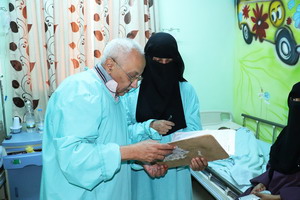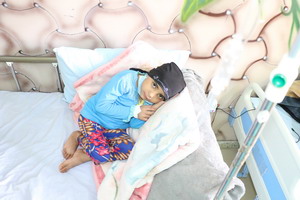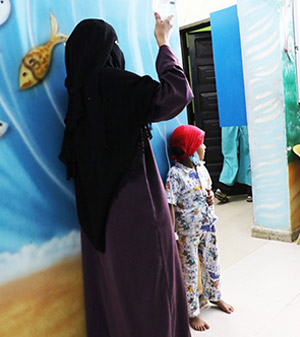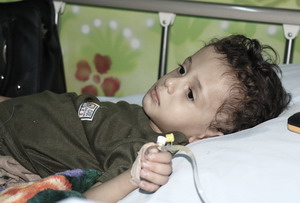 Dr Abdulrahman Al-Hadi faces a sad reality daily, one that reflects the overall situation in Yemen. “Some patients die because life-saving medications are unavailable at the Centre. Some medications cost US$ 100 or more and people don’t have even a fraction of that amount” (Photo: WHO/Sadeq Al-Wesabi).20 November 2018 – Millions are living through the worst humanitarian crises in the world. In a world where basic infrastructure and services are a presumed part of daily life, Yemeni citizens struggle to meet simple needs of access to clean water, sanitation, food and primary health care. The energy formerly spent on development and capacity-building is being wasted on struggling to stay alive and healthy.
Dr Abdulrahman Al-Hadi faces a sad reality daily, one that reflects the overall situation in Yemen. “Some patients die because life-saving medications are unavailable at the Centre. Some medications cost US$ 100 or more and people don’t have even a fraction of that amount” (Photo: WHO/Sadeq Al-Wesabi).20 November 2018 – Millions are living through the worst humanitarian crises in the world. In a world where basic infrastructure and services are a presumed part of daily life, Yemeni citizens struggle to meet simple needs of access to clean water, sanitation, food and primary health care. The energy formerly spent on development and capacity-building is being wasted on struggling to stay alive and healthy.
Almost four years of war has pushed an already weak health system to near ruin. People with chronic illnesses are struggling more than ever before to access treatment. The current situation forces 35 000 cancer patients – and nearly 11 000 new cases are diagnosed yearly – to hope only to survive rather than thrive. Almost half of the hospitals and health facilities have been destroyed due to the war, leaving the health system teetering on the brink of collapse.
The Leukaemia Centre in Sana’a is the only specialized leukaemia treatment centre for children in Yemen. With zero government support the Centre is in dire need of supplies and what is available covers only a fraction of the needs of incoming patients.
Tamir Abdulqader from Al Hudaydah governorate is seven years old and is one of three siblings. Pain in his joints three months ago prompted his mother to seek medical advice; unfortunately, he was misdiagnosed until he came to the Leukaemia Centre in Sana’a where he is currently receiving proper treatment. Tamir’s mother who accompanies him does not have anyone to support her, including her husband. “Once he learned about Tamir’s diagnosis, he told me that he is dead to him. We are divorced now and I don’t have anyone to help me” she says. Not only is she in debt after being forced to move to Sana’a for treatment, her two other children have been left with their grandmother in Al Hudaydah, who has been forced to sell her belongings just to make ends meet.
Poverty, vulnerability, and lack of supplies
Being the only specialized centre in Yemen, there is a great deal of pressure placed on the Leukaemia Centre that it is not equipped to take on. The sheer number of patients coming in from all governorates exceeds the available capacity and medical supplies. “Many patients coming in can’t afford to buy even the basic supplies such as an IV or cough medicine” says Dr Abdulrahman Al Hady, Director of the centre in Sana’a.
 The Leukaemia Centre continues to receive patients from all over the country in significantly rising numbers, while severely lacking supplies and medication. (Photo: WHO/Sadeq Al-Wesabi).
The Leukaemia Centre continues to receive patients from all over the country in significantly rising numbers, while severely lacking supplies and medication. (Photo: WHO/Sadeq Al-Wesabi).
Shaima, seven, sits in the other room with her mother who accompanies her. In a pink headscarf, her tired little face seems even smaller, though her eyes still shine with the light of hope. She was diagnosed with leukaemia a few months ago after being in a car accident that injured her foot. “She was very scared and had a persistent fever for a few days after the accident. Her joints started to hurt her and that’s when I took her to the hospital,” says Shaima’s mother.
She tried two hospitals that rejected her admission before being admitted into the Leukaemia Centre. “We don’t have a place to stay, so we move around and stay with relatives whenever we can.”
With 22.2 million requiring humanitarian assistance, those with chronic diseases fall through the cracks
 Shaima was diagnosed with leukaemia a few months ago after being in a car accident that injured her foot. Her family tried two hospitals that rejected her admission before being admitted into the Centre. (Photo: WHO/Sadeq Al-Wesabi).Many families of patients suffering from chronic diseases face devastating circumstances and struggles in their plight to access medical care. Poverty, lack of resources and medical care is common to millions of Yemeni people. About 75% – some 22.2 million people – require humanitarian or protection assistance, and more than half of them (11.3 million) require acute assistance, an increase of 1 million since July 2017.
Shaima was diagnosed with leukaemia a few months ago after being in a car accident that injured her foot. Her family tried two hospitals that rejected her admission before being admitted into the Centre. (Photo: WHO/Sadeq Al-Wesabi).Many families of patients suffering from chronic diseases face devastating circumstances and struggles in their plight to access medical care. Poverty, lack of resources and medical care is common to millions of Yemeni people. About 75% – some 22.2 million people – require humanitarian or protection assistance, and more than half of them (11.3 million) require acute assistance, an increase of 1 million since July 2017.
The Leukaemia Centre continues to receive patients from all over the country in significantly rising numbers, while severely lacking supplies and medication. Only 20% or less of their needs are covered, and the death rate is higher than ever. “Sometimes incoming patients can’t afford to purchase the supplies that are not covered by the Centre, and out of compassion, doctors purchase these supplies themselves to assist those patients” Dr Abdulrahman adds. With the exchange rate of the US dollar increasing dramatically, prices of medication have sky-rocketed, tripling in price while most of the population struggle to put food on the table.
 Many families of patients suffering from chronic diseases, like Hussein, face devastating circumstances and struggles in their plight to access medical care (Photo: WHO/Sadeq Al-Wesabi).Hashed is six years old and has been sick for five months now. He sits on the hospital bed and his eyes are fixed on a very small TV screen on the wall playing children’s songs, his energy drained by his disease. His mother had to move to Sana’a from Ibb governorate with her thee children to seek treatment for Hashed. “He started experiencing pain in his legs. They became stiff which prevented him from walking,” says Hashed’s mother. After Hashed’s diagnosis they were advised to travel abroad for treatment that wasn’t available in the country, but they couldn’t afford the expense.
Many families of patients suffering from chronic diseases, like Hussein, face devastating circumstances and struggles in their plight to access medical care (Photo: WHO/Sadeq Al-Wesabi).Hashed is six years old and has been sick for five months now. He sits on the hospital bed and his eyes are fixed on a very small TV screen on the wall playing children’s songs, his energy drained by his disease. His mother had to move to Sana’a from Ibb governorate with her thee children to seek treatment for Hashed. “He started experiencing pain in his legs. They became stiff which prevented him from walking,” says Hashed’s mother. After Hashed’s diagnosis they were advised to travel abroad for treatment that wasn’t available in the country, but they couldn’t afford the expense.
“We can hardly afford the medication prescribed here. We have to buy the cheaper brands because the good ones are very expensive,” she adds.
Dr Abdulrahman faces a sad reality daily, one that reflects the overall situation in Yemen. “Some patients die because life-saving medications are unavailable at the Centre. Some medications cost US$ 100 or more and people don’t have even a fraction of that amount.”
To add to this dire situation, health workers continue to work tirelessly for hours on end without a salary, thereby unable to provide for their own families.
WHO continues to support the National Oncology Centre in Sana’a and its branches in all governorates with various essential and life-saving anti-cancer medicines and chemotherapy medication. This medication is sufficient to cover the acute shortages of medicines for more than 30 000 cancer patients for one year — but this is not enough. More needs to be done or many more people will die from preventable and treatable diseases.








